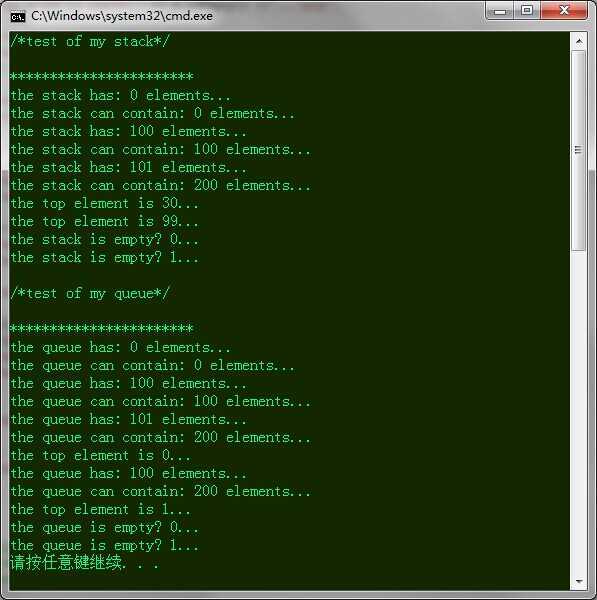标签:style blog http io os ar for sp div
#include <string.h>
#include <stdlib.h>
#include <iostream>
#include <exception>
using namespace std;
class MyException : public exception
{
public:
MyException() :exception("the stack is empty...\n")
{
}
MyException(int a) :exception("the queue is empty...\n")
{
}
};
template <typename T>
class Stack
{
int Size;
int Room;
T* data;
public:
Stack()
{
Size = 0;
Room = 0;
data = NULL;
}
Stack(int MAX)
{
Size=0;
Room = MAX;
data = (T*)malloc(sizeof(T)*MAX);
}
int size()
{
return Size;
}
int room()
{
return Room;
}
void push(T m)
{
if(Room>Size)
{
*(data+Size)=m;
++Size;
}
else
{
data = (T*)realloc(data,(Room+100)*sizeof(T));
*(data+Size)=m;
++Size;
Room+=100;
}
}
void pop()
{
try
{
if (Size)
{
--Size;
}
else
throw MyException();
}
catch (MyException &e)
{
cout << e.what();
}
}
T getTop()
{
try
{
if (Size)
{
return *(data + Size - 1);
}
else
throw MyException();
}
catch (MyException &e)
{
cout << e.what();
}
}
void clear()
{
Size=0;
Room=0;
free(data);
data=NULL;
}
bool isEmpty()
{
if (!Size)return true;
else return false;
}
};
template <typename T>
class Queue
{
int Size;
int Room;
int Head;
T* data;
public:
Queue()
{
Size = 0;
Room = 0;
Head = 0;
data = NULL;
}
Queue(int MAX)
{
Size = 0;
Room = MAX;
Head = 0;
data = (T*)malloc(sizeof(T)*MAX);
}
int size()
{
return Size;
}
int room()
{
return Room;
}
void enqueue(T m)
{
if (Room > Size)
{
*(data + Room - Size -1) = m;
++Size;
}
else
{
T* temp = (T*)malloc(sizeof(T)*(Room + 100));
memcpy(temp + 100, data, sizeof(T)*Room);
data = temp;
Room += 100;
*(data + Room - Size -1) = m;
++Size;
}
}
void dequeue()
{
try
{
if (Size)
{
--Size;
++Head;
}
else
throw MyException(0);
}
catch (MyException &e)
{
cout << e.what();
}
}
T getHead()
{
try
{
if (Size)
{
return *(data + Room -Head -1);
}
else throw MyException(0);
}
catch (MyException &e)
{
cout << e.what();
}
}
void clear()
{
Size = 0;
Room = 0;
Head = 0;
free(data);
data = NULL;
}
bool isEmpty()
{
if (Size)return false;
else return true;
}
};
int main(int argc, char* argv[])
{
cout << "/*test of my stack*/\n\n";
cout << "***********************\n";
Stack<int> s;
cout << "the stack has: " << s.size() << " elements...\n";
cout << "the stack can contain: " << s.room() << " elements...\n";
for (int i = 0; i < 100; ++i)
s.push(i);
cout << "the stack has: " << s.size() << " elements...\n";
cout << "the stack can contain: " << s.room() << " elements...\n";
s.push(30);
cout << "the stack has: " << s.size() << " elements...\n";
cout << "the stack can contain: " << s.room() << " elements...\n";
cout << "the top element is " << s.getTop() <<"...\n";
s.pop();
cout << "the top element is " << s.getTop() << "...\n";
cout << "the stack is empty? " << s.isEmpty()<<"...\n";
s.clear();
cout << "the stack is empty? " << s.isEmpty() <<"...\n\n";
cout << "/*test of my queue*/\n\n";
cout << "***********************\n";
Queue<int> t;
cout << "the queue has: " << t.size() << " elements...\n";
cout << "the queue can contain: " << t.room() << " elements...\n";
for (int j = 0; j < 100; ++j)
t.enqueue(j);
cout << "the queue has: " << t.size() << " elements...\n";
cout << "the queue can contain: " << t.room() << " elements...\n";
t.enqueue(-1);
cout << "the queue has: " << t.size() << " elements...\n";
cout << "the queue can contain: " << t.room() << " elements...\n";
cout << "the top element is " << t.getHead() <<"...\n";
t.dequeue();
cout << "the queue has: " << t.size() << " elements...\n";
cout << "the queue can contain: " << t.room() << " elements...\n";
cout << "the top element is " << t.getHead() << "...\n";
cout << "the queue is empty? " << t.isEmpty()<<"...\n";
t.clear();
cout << "the queue is empty? " << t.isEmpty() <<"...\n";
return 0;
}
//栈的结构通过连续内存(数组)来模拟,数组的尾端相当于栈顶
//出栈操作并没有将栈顶元素删除,只是通过Size自减1,使得原栈顶元素无法访问
//队列的结构同样也是通过连续内存(数组)来模拟,数组的尾端相当于队首
//出列操作也同样没有将队首元素删除,只是通过Head自加1,使得原队首元素无法访问

标签:style blog http io os ar for sp div
原文地址:http://www.cnblogs.com/gardonkoo/p/4019186.html